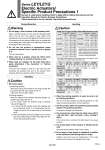
121-210-e-ley-en@@@58 / 104
10bÐèBOOKäy[WèÖÛçÉñ
Design/Selection Warning 1. Do not apply a load in excess of the operating limit. Select a suitable actuator by work load and allowable lateral load on the rod end. If the product is used outside of the operating limit, the eccentric load applied to the piston rod will be excessive and have adverse effects such as creating play on the sliding parts of the piston rod, degrading accuracy and shortening the life of the product. 2. Do not use the product in applications where excessive external force or impact force is applied to it. This can cause failure. 3. When used as a stopper, select the LEYG series gSliding bearingh for a stroke of 30 mm or less. 4. When used as a stopper, fix the main body with a guide attachment (gTop mountingh or gBottom mountingh). If the end of the actuator is used to fix the main body (end mounting), the excessive load acts on the actuator, which adversely affects the operation and life of the product. Handling Caution 1. INP output signal 1) Positioning operation When the product comes within the set range by step data [In position], the INP output signal will turn on. Initial value: Set to [0.50] or higher. 2) Pushing operation When the effective force exceeds step data [Trigger LV], the INP output signal will turn on. Use the product within the specified range of [Pushing force] and [Trigger LV]. a) To ensure that the actuator pushes the workpiece with the set [Pushing force], it is recommended that the [Trigger LV] be set to the same value as the [Pushing force]. b) When the [Pushing force] and [Trigger LV] are set less than the specified range, the INP output signal will turn on from the pushing start position. Handling Caution 2. When the pushing operation is used, be sure to set to [Pushing operation]. Also, do not hit the workpiece in positioning operation or in the range of positioning operation. It may malfunction. 3. Use the product within the specified pushing speed range for the pushing operation. It may lead to damage and malfunction. 4. The moving force should be the initial value (LEY16 ÞÛ/25ÞÛ/32ÞÛ/40ÞÛ: 100%, LEY16AÞÛ: 150%, LEY25AÞÛ: 200%). If the moving force is set below the initial value, it may cause an alarm. 5. The actual speed of this actuator is affected by the load. Check the model selection section of the catalog. 6. Do not apply a load, impact or resistance in addition to the transferred load during return to origin. Additional force will cause the displacement of the origin position since it is based on detected motor torque. Model Pushing speed [mm/s] Pushing force (Setting input value) 1 to 4 5 to 20 21 to 50 1 to 4 5 to 20 21 to 35 1 to 4 5 to 20 21 to 30 1 to 4 5 to 20 21 to 30 85% 30% to 85% 35% to 85% 60% to 85% 20% to 65% 35% to 65% 50% to 65% 20% to 85% 35% to 85% 60% to 85% 20% to 65% 35% to 65% 50% to 65% LEYÞÛ16ÞÛ LEYÞÛ25ÞÛ LEYÞÛ32ÞÛ LEYÞÛ40ÞÛ